
Lambert de Hondt the Elder or Lambert de Hondt (I) (c. 1620 - before 10 February 1665) was a Flemish painter and draughtsman mainly known for his equestrian and battle scenes as well as his genre and landscape paintings. [1]

Lambert de Hondt the Elder or Lambert de Hondt (I) (c. 1620 - before 10 February 1665) was a Flemish painter and draughtsman mainly known for his equestrian and battle scenes as well as his genre and landscape paintings. [1]
Only a few details about de Hondt's life have been preserved. He is recorded as working in Mechelen. Since his widow remarried on 10 February 1665, we know he died before that date. He is sometimes confused with another artist who signed his paintings with L. de Hondt. [2] This other artist who also specialised in battle scenes and made designs for tapestries around 1700 is referred to as Lambert de Hondt the Younger. It is not known whether the two artists were related.

De Hondt must have enjoyed high-level patronage as one of his paintings ( An Encampment with Soldiers Playing Cards , now at the Wellington Museum, Apsley House, London) is marked with a white fleur-de-lis, and originally had a coat of arms on the back. This indicates that the painting was in the collection of Elisabeth Farnese. [2]
He was probably responsible for the compositions depicting military camps, cavalry and military convoys and battles signed L.D. HONDT. These paintings are reminiscent of the manner of David Teniers the Younger. In his military scenes he often used a sketchy technique. [2] His paintings mostly depict horses and cavalry. He also painted village scenes (such as The Vegetable Vendor ), hunting scenes (such as A Hunting Scene ) and landscapes. [1]

As was the custom at the time, he regularly collaborated with other painters. He worked with Willem van Herp in the production of landscapes (painted by de Hondt) with figures (painted by van Herp) such as Noah gathering his Family and the Animals on the Ark, Orpheus charming the animals, St. Francis with the Animals, etc. [3] These paintings are similar in composition and are a variation of the type of the so-called 'paradise landscape'. Paradise landscapes depict the Garden of Eden as described in the Book of Genesis , filled with all the animals, fish and birds that were believed to be God's creation. The type was invented and popularized by Jan Brueghel the Younger. Jan Brueghel was employed at the court of the Archdukes Albert and Isabella in Brussels, which maintained an extensive animal menagerie. As a native of Antwerp, a major port city and trading center for exotic goods and animals from Asia and the New World, Brueghel would have been able to witness these exotic animals alive. Jan Brueghel was thus in an ideal position to study many domestic and exotic animal species and include them in his compositions. De Hondt was manifestly inspired by Brueghel's paradise landscapes such as Brueghel's The Creation of Adam and The Entry of the Animals into Noah's Ark . He was clearly also familiar with Rubens' animal scenes as his depiction of the lions in his 'paradise paintings' resemble those of Rubens in the painting Daniel in the Lion's Den .
He occasionally painted on copper, a support which offered a perfectly smooth surface allowing the precise detail of the paradise paintings. [4]

Jan Brueghelthe Elder was a Flemish painter and draughtsman. He was the son of the eminent Flemish Renaissance painter Pieter Bruegel the Elder. A close friend and frequent collaborator with Peter Paul Rubens, the two artists were the leading Flemish painters in the first three decades of the 17th century.
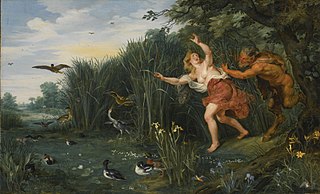
Jan Brueghelthe Younger was a Flemish Baroque painter. He was the son of Jan Brueghel the Elder, and grandson of Pieter Bruegel the Elder, both prominent painters who contributed respectively to the development of Renaissance and Baroque painting in the Habsburg Netherlands. Taking over his father's workshop at an early age, he largely painted the same subjects as his father in a style which was similar to that of his father. He gradually was able to break away from his father's style by developing a broader, more painterly, and less structured manner of painting. He regularly collaborated with leading Flemish painters of his time.
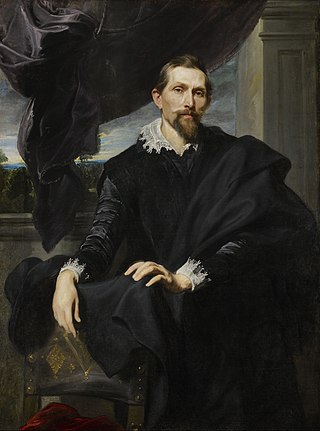
Frans Snyders or Frans Snijders was a Flemish painter of animals, hunting scenes, market scenes, and still lifes. He was one of the earliest specialist animaliers and he is credited with initiating a wide variety of new still-life and animal subjects in Antwerp. He was a regular collaborator with leading Antwerp painters such as Peter Paul Rubens, Anthony van Dyck, and Jacob Jordaens.

David Teniers the Younger or David Teniers II was a Flemish Baroque painter, printmaker, draughtsman, miniaturist painter, staffage painter, copyist and art curator. He was an extremely versatile artist known for his prolific output. He was an innovator in a wide range of genres such as history painting, genre painting, landscape painting, portrait and still life. He is now best remembered as the leading Flemish genre painter of his day. Teniers is particularly known for developing the peasant genre, the tavern scene, pictures of collections and scenes with alchemists and physicians.
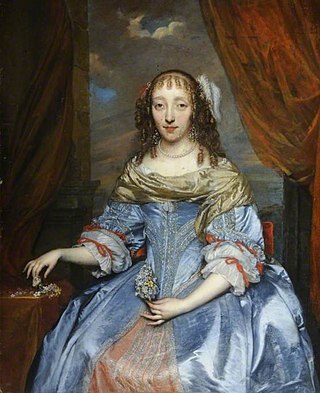
Gonzales Coques was a Flemish painter of portraits and history paintings. Because of his artistic proximity to and emulation with Anthony van Dyck he received the nickname de kleine van Dyck. Coques also worked as an art dealer.
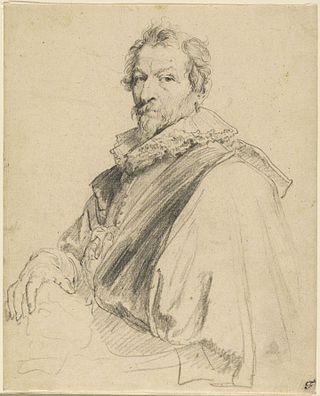
Hendrick van Balen or Hendrick van Balen I was a Flemish Baroque painter and stained glass designer. Hendrick van Balen specialised in small cabinet pictures often painted on a copper support. His favourite themes were mythological and allegorical scenes and, to a lesser extent, religious subjects. The artist played an important role in the renewal of Flemish painting in the early 17th century and was one of the teachers of Anthony van Dyck.
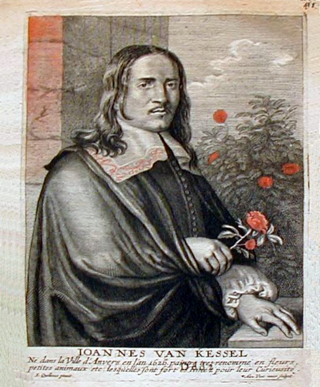
Jan van Kessel the Elder or Jan van Kessel (I) (baptized 5 April 1626, Antwerp – 17 April 1679, Antwerp) was a Flemish painter active in Antwerp in the mid 17th century. A versatile artist he practised in many genres including studies of insects, floral still lifes, marines, river landscapes, paradise landscapes, allegorical compositions, scenes with animals and genre scenes. A scion of the Brueghel family many of his subjects took inspiration of the work of his grandfather Jan Brueghel the Elder as well as from the earlier generation of Flemish painters such as Daniel Seghers, Joris Hoefnagel and Frans Snyders. Van Kessel’s works were highly prized by his contemporaries and were collected by skilled artisans, wealthy merchants, nobles and foreign luminaries throughout Europe.
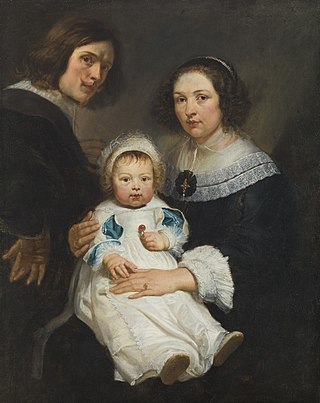
Erasmus Quellinus the Younger or Erasmus Quellinus II (1607–1678) was a Flemish painter, engraver, draughtsman and tapestry designer who worked in various genres including history, portrait, allegorical, battle and animal paintings. He was a pupil of Peter Paul Rubens and one of the closest collaborators of Rubens in the 1630s. Following Rubens' death in 1640 he became one of the most successful painters in Flanders. He was a prolific draughtsman who made designs for decorative programmes in the context of official celebrations, for publications by the local publishers and for tapestries and sculptures realised by the local workshops. His work reveals the Classicist trend in the Baroque.
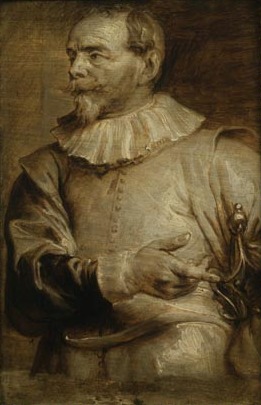
Sebastiaen Vrancx, Sebastiaan Vrancx or Sebastian Vranckx was a Flemish Baroque painter, draughtsman and designer of prints who is mainly known for his battle scenes, a genre that he pioneered in Netherlandish painting. He also created landscapes with mythological and allegorical scenes, scenes with robbers, village scenes and celebrations in cities. He was a gifted figure painter who was regularly invited to paint the staffage in compositions of fellow painters. As an active member of a local chamber of rhetoric, he wrote comedies and a number of poems. He was further captain of the Antwerp civil militia schutterij.

Flemish Baroque painting was a style of painting in the Southern Netherlands during Spanish control in the 16th and 17th centuries. The period roughly begins when the Dutch Republic was split from the Habsburg Spain regions to the south with the Spanish recapturing of Antwerp in 1585 and goes until about 1700, when Spanish Habsburg authority ended with the death of King Charles II. Antwerp, home to the prominent artists Peter Paul Rubens, Anthony van Dyck, and Jacob Jordaens, was the artistic nexus, while other notable cities include Brussels and Ghent.

Frans Francken the Younger was a Flemish painter who created altarpieces and furniture panels and gained his reputation chiefly through his small and delicate cabinet pictures with historical, mythological or allegorical themes. He is the best-known and most prolific member of the large Francken family of artists. Francken played an important role in the development of Flemish art in the first half of the 17th century through his innovations in many genres including genre painting and his introduction of new subject matter. He was a frequent collaborator of leading Antwerp painters of his time.

Tobias Verhaecht (1561–1631) was a painter from Antwerp in the Duchy of Brabant who primarily painted landscapes. His style was indebted to the mannerist world landscape developed by artists like Joachim Patinir and Pieter Bruegel the Elder. He was the first teacher of Pieter Paul Rubens.

Willem van Herp (I) or Willem van Herp the Elder (variations on first name: 'Guilliam', 'Gilliam' and 'Guillaume') (c. 1614 in Antwerp – 1677) was a Flemish Baroque painter specializing in religious paintings and small cabinet paintings of "low-life" genre scenes. He operated a large workshop and through his good connections with Antwerp art dealers helped spread the Flemish Baroque style internationally.

Pieter van Avont or Peter van Avont, (1600–1652) was a Flemish painter, draughtsman and printmaker known for his religious scenes and cabinet paintings often including nude children and putti. Van Avont was a frequent collaborator with many leading painters in Antwerp.

Jan van Balen was a Flemish painter known for his Baroque paintings of history and allegorical subjects. He also painted landscapes and genre scenes.

Abraham Willemsens or Abraham Willemsen, was a Flemish painter of history and genre paintings. His genre scenes were reminiscent of the style of the Le Nain brothers. He also produced copies after the works of Rubens.

Izaak van Oosten, Isaak van Oosten or Isaac van Oosten was a Flemish Baroque landscape and cabinet painter active in Antwerp.

The Garden of Eden with the Fall of Man or The Earthly Paradise with the Fall of Adam and Eve is a painting by Peter Paul Rubens (figures) and Jan Brueghel the Elder. It is housed in the Mauritshuis art museum in The Hague, Netherlands. The painting depicts the moment just before the consumption of forbidden fruit and the fall of man.
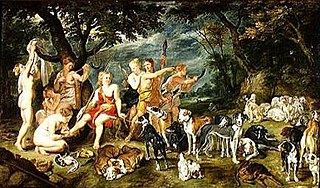
Diana and Her Nymphs Leaving for the Hunt is a 1623–1624 oil on panel painting by Peter Paul Rubens (figures) and Jan Brueghel the Elder. Diana It is now in the Musée de la Chasse et de la Nature in Paris. During his life, Rubens hoped to encourage the painting of classicist hunting scenes.

Mathys Schoevaerdts or Matthijs Schoevaerdts was a Flemish painter, draughtsman and printmaker. He is known mainly for his landscapes with trees, marines and genre scenes. He started out in the tradition of Jan Brueghel the Elder and later developed towards an Italianate style.